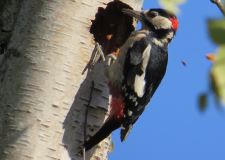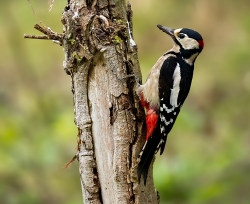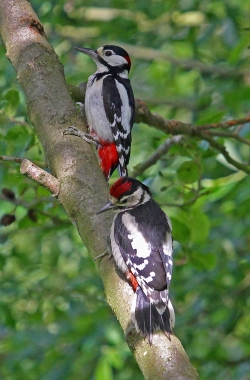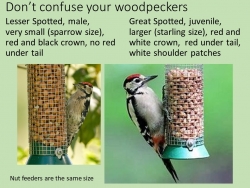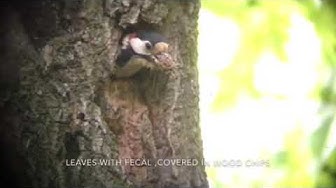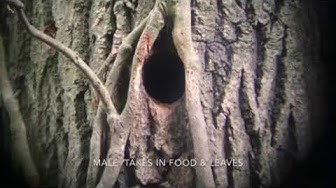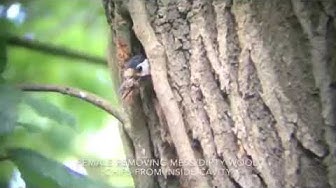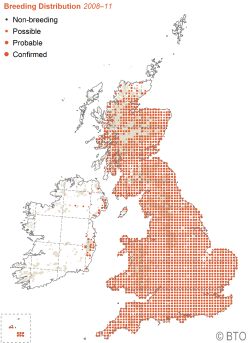
Great Spotted Woodpeckers are resident and common throughout Britain. The map shows the breeding distribution from the latest BTO Atlas (2008-11). Great Spots were not present in Ireland until 2008.
We will use these pages to report some current and past observations and studies of these fascinating birds.
Great Spot numbers increased rapidly in the 1970s and began a further increase in the mid-1990s. The chart shows breeding population index from 1966-2017 derived from Common Bird Census/Breeding Bird Survey data (BTO/JNCC Bird Trends Report).
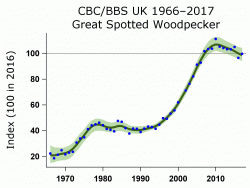 The BTO estimate the population to be 140,000 pairs in 2009. This is in stark contrast to the estimated 1500 pairs of Lesser Spotted Woodpeckers.
The BTO estimate the population to be 140,000 pairs in 2009. This is in stark contrast to the estimated 1500 pairs of Lesser Spotted Woodpeckers.
Ken and Linda Smith studied Great Spotted Woodpeckers in their local woodlands in Hertfordshire for 35 years before moving to Sussex in 2016.
Between 2001-2016 they monitored 836 Great Spot nests to record the breeding parameters, first egg date, clutch size, fledging success, etc. Some of the results of their studies are reported on these pages (see below) and thier latest research was published in August 2019 in the BTO journal Bird Study - see 10 August news story here.
We also report current observations by other Woodpecker Network obervers. Please let us know if you have information to share.
Great Spots in Norwich in 2020
Woodpecker Network observers Ricky Cleverley and Mat Shore have been watching and filming events at 14 Great Spot nests in Norwich. You can follow them on Twitter. @NExplored
We will be posting information and videos of the 2020 nests shortly. The videos bring to life the history and success of the nests, showing the type of food brought and the adults cleaning the nest. They have also been tracking 7 Green Woodpecker nests and we will be posting a special webpage on these shortly.
Some of the 2019 video stories are here, Click on the photos to watch the videos.
The Hertfordshire Great Spotted Woodpecker studies 1981-2016
Ken and Linda Smith’s studies of breeding Great Spotted Woodpeckers were carried out between 1981 and 2016. In total 836 nests were studied in four mature woodlands in Hertfordshire, southern England (Wormley Wood, Hoddesdonpark Wood, Sherrardspark Wood and Hitch Wood) with total area of 350ha (Smith 1997, 2005 & 2006). All the woods were dominated by Oak with other species such as Hornbeam, Beech, Sweet, Birch and Ash present to varying degrees in each wood (Smith 2005).
Each year they attempted to find all the nests in these four woods by systematic searches and to follow their outcomes. In the last two decades about 50 nests have been found each year with nest contents determined by using video nest inspection cameras on telescopic poles (Smith & Charman 2012). Nests were found at all stages of the nesting cycle but once found they were checked every few days and inspected with the video nest camera to determine the clutch size, numbers of chicks fledged and the timing of egg laying and fledging. To determine the numbers of young fledged the nests were inspected just before the young were due to fledge and a few days afterwards to check for any unfledged young left in the nest.
They also monitored the timing and abundance of defoliating caterpillars, a major food source for breeding woodpeckers, using frass trays and damage assessments of Oak leaves. The results of this work have just been published (19 July 2019) in the BTO Journal Bird Study, read all about it on our news pages here Does the abundance and timing of defoliating caterpillars influence the nest survival and productivity of the Great Spotted Woodpecker.
Do Great Spotted Woodpeckers migrate?
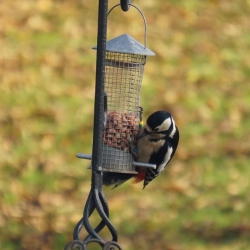
However this thinking has been overturned by one amazing female Great Spot monitored as part of Ken and Linda’s study in Hertfordshire. An adult female was caught at its nest in Wormley Wood 2014 and colour ringed ‘green on yellow’.
To their surprise the female ‘green on yellow’ was photographed on a nut feeder 100km away in Northamptonshire in November 2014. An unusual long distance movement in itself.
But to their amazement it was found nesting again in the same area of the wood in 2016 and was back in Northampton again over the winter in January 2017. It returned to nest in Wormley Wood in 2017. Then to amazement all round it was seen again in Robert Cave’s garden in Northamptonshire on 23 December 2018.
This was the first time regular migration has been reported for Great Spotted Woodpeckers. Read the full story and the paper published in 'British Birds'.
References to published papers on Woodpeckers by Ken Smith (and a few including Linda !!!)
Smith, K.W. 1997. Nest site selection of the great spotted woodpecker Dendrocopos major in two oak woods in southern England and its implications for woodland management. Biol. Conserv. 80: 283-288.
Smith, K.W. 2005. Has the reduction in nest-site competition from Starlings Sturnus vulgaris been a factor in the recent increase of Great Spotted Woodpecker Dendrocopos major numbers in Britain? Bird Study 52: 307-313.
Smith, K.W. 2006. The implications of nest site competition from starlings Sturnus vulgaris and the effect of spring temperatures on the timing and breeding performance of great spotted woodpeckers Dendrocopos major in southern England. Ann. Zool. Fennici 43: 177–185.
Smith, K.W., Smith, L., Charman, E., Briggs, K., Burgess, M., Dennis, C., Harding, M., Isherwood, C., Isherwood, I. & Mallord, J. 2011. Large-scale variation in the temporal patterns of the frass fall of defoliating caterpillars in oak woodlands in Britain: implications for nesting woodland birds. Bird Study 58: 506-511.
Smith, K.W. & Charman, E.C. 2012. The ecology and conservation of the Lesser Spotted Woodpecker. British Birds 105: 294-307.
Smith, K.W. & Smith, L. 2013. The effect of supplementary feeding in early spring on the breeding performance of the Great Spotted Woodpecker Dendrocopos major. Bird Study 60: 169-175.
Smith, K.W. & Smith L. 2019. Does the abundance and timing of defoliating caterpillars influence the nest survival and productivity of the Great Spotted Woodpecker Dendrocopos major? Bird Study 66: 187-197.
SpringWatch 2019 Great Spotted Woodpecker nest in Abernethy Forest in the Cairngorms.
Springwatch has been following a Great Spot nest with four youngsters likely to fledge on 15th June. As this is so late in the season and the weather in Scotland has been so cold and wet, the chicks look very hungry and the adults are struggling to find them food. There will be drama tonight when the woodpeckers raid one of the other nests featured on the show !!
Great Spots are well known to take chicks from other birds nests, including Blue Tits, Great Tits and Lesser Spotted Woodpeckers! This is particularly likely late in the season when other food tends to be short.
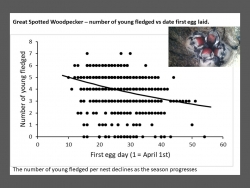 Early nests are more successful in that more young are fledged. The chart shows results from Ken and Linda Smith's 16 year study of breeding Great Spots in Hertfordshire. Significantly more young fledge (up to 6) from nests where the first eggs are laid in early April than from nests where the first egg was laid in May (3 or less).
Early nests are more successful in that more young are fledged. The chart shows results from Ken and Linda Smith's 16 year study of breeding Great Spots in Hertfordshire. Significantly more young fledge (up to 6) from nests where the first eggs are laid in early April than from nests where the first egg was laid in May (3 or less).
News story - 6 June 2019 - BBC Springwatch are currently following a Great Spot nest in a pine tree in Abernethy Forest and found that the nest holes tend to be orientated to the northeast.
Ken and Linda Smith's study of 836 Great Spotted Woodpecker nests in Hertfordshire also found a small but statistically significant bias for the holes to be facing northeast – the mean direction being 40 degrees east of north. However, when we look in detail at the data, the effect is quite subtle.
Great Spotted Woodpeckers place their nests in both live and dead trees, sometimes in the tree trunk and sometimes in larger limbs on the trees. We find there is no overall selection for any particular orientation for nest holes in limbs or live trees, but the nest holes in dead trees are strongly orientated to the northeast. Read the full story here
